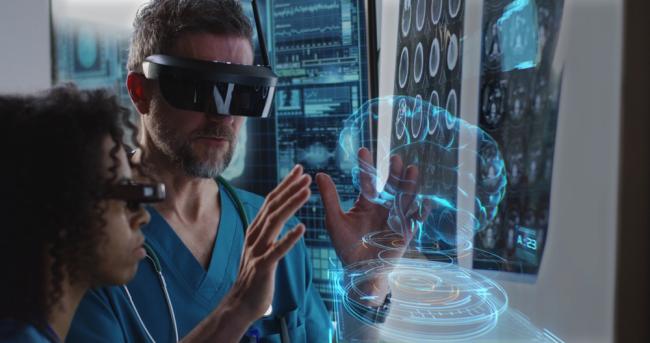Topics
The Changing Technology Landscape of Medical Education and Communication

The world is entering a new era of medicine, one that challenges the very physical barriers that divide us. Spearheading this revolution is the clever manipulation of reality in augmented, virtual, and mixed environments to provide access to doctors for patients from anywhere in the world. Supplemented by advanced artificial intelligence systems, the students of today are set to become some of the most proficient physicians in human history.
What technologies are currently available? What new obstacles will tomorrow bring? These considerations will be critical in identifying areas for innovation in modern medicine and determining how best to prepare for the future. The ongoing pandemic is a potent reminder of the dangers of complacency in a globally connected society. The rapid integration of these and other technologies will be crucial to our ongoing relevance as a species and cultivate explosive growth in the healthcare industry.
The global market size for augmented and virtual reality in healthcare was approximately $800 million in 2019 and is expected to exceed $3.5 billion by the end of 2026. eMarketer projects that over 83 million people in the United States will use AR at least once per month in 2020, a quarter of its population. Europe, North America, and Asia-Pacific remain the primary markets.
Healthcare systems are notoriously asynchronous, with most hospitals operating relatively independent of one another. AR systems provide the opportunity for seamless integration of medical teams at a distance. A sudden influx of patients can quickly lead to strained hospital resources; with the integration of AR technologies, medical professionals can be rapidly recruited to the facilities where they’re needed and healthcare providers can even reach their patients in non-medical settings. Experts may be virtually recruited to pandemic hotspots to quickly bolster the frontline of a sudden outbreak that otherwise might have overwhelmed local hospital resources. Professionals can also access patients in remote emergencies such as in schools, open water, or an accident.
A majority of VR and AR applications have thus far been applied to anatomy and physiology. Massive online databases house meticulously detailed information on the mechanisms and structure of the human body and the mechanisms of its physiology. This information is used to simulate a digital rendition of human forms for interaction and study and provide a significantly more intimate educational experience. Manifestations of this so-called “in silico” biology links concepts dynamically to produce a more holistic understanding for students. Hololens by Microsoft has exemplified this elegantly in their work with Case Western Reserve University to provide state-of-the-art technology for a cadaver-free facility for medical students. After donning a set of glasses, students can interact with a digital model of the human brain in a fully immersive environment.
AR technology has also empowered companies focused on life sciences to more clearly educate healthcare providers on their products. Pharmaceutical companies can produce immersive illustrations of their products and showcase the impact throughout the course of a given disease, and thus more clarity to patients by extension. EyeDecide uses augmented reality to simulate ophthalmological issues for patients to more accurately communicate their symptoms. AR assistance can be broadly applied from assisting nurses in finding veins, to helping surgeons in the operating room.
Research into the efficacy of virtual and augmented training techniques overwhelmingly supports its positive impacts. Systems can require a sizeable investment but provide freely reproducible training sessions tailored to the desired difficulty and outcome of users. Studies have confirmed the acceleration of the learning process, improved performance accuracy, and a decrease in practice required. In examining the efficacy of augmented reality for the learning of anatomy, “100% of respondents reported that AR either greatly or partially facilitated learning.” Students in this study scored significantly higher on academic tests than their traditionally trained peers. Over three separate studies, 80.5% of physicians rated AR as “Excellent” or “Good,” and all unanimously recommended AR be used to supplement current anatomy curriculums. Indeed, the growing number of augmented reality applications are rapidly adapting to every feasible facet of medical education.
As the COVID-19 pandemic continues to suspend traditional formats, educators are increasingly turning to alternatives in remote education. Wearing the Microsoft HoloLens, a physician attending to a COVID patient can share a feed of treatment in real-time to virtually any number of observers without the need for additional PPE. Similarly, the outbreak has pushed remote-assistance into active duty on the frontline, as medical workers are rapidly trained in the operation of ventilators through the virtual projection and instructions superimposed over their view of the real-world.
Adoption is rapidly progressing for this exciting technology, and the myriad of applications will only continue to expand. CGS’s Teamwork AR provides step-by-step AR training on any device, anywhere to give a rich and thorough learning experience. More than ever, the need for virtual training for medical personnel is paramount, and it will be through such technologies that the challenges of the pandemic will be overcome.
Resources
https://www.industryresearch.co/global-augmented-reality-and-virtual-rea...
https://www.emarketer.com/content/us-virtual-and-augmented-reality-users...
https://www.intechopen.com/books/medical-and-surgical-education-past-pre...
https://medcitynews.com/2019/09/the-benefits-of-ar-in-healthcare/?rf=1
https://www.intechopen.com/books/medical-and-surgical-education-past-pre...
https://www.ncbi.nlm.nih.gov/pmc/articles/PMC7082471/
https://www.forbes.com/sites/jamessomauroo/2020/06/19/virtual-reality-he...
https://www.wsj.com/articles/coronavirus-pandemic-brings-new-use-cases-f...

